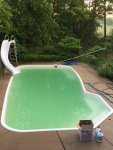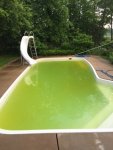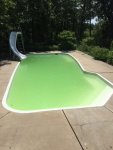Greetings TFP Community! I’m new here but have been doing LOTS of reading to try and help prepare myself for the Baquacil to Chlorine conversion. Many thanks to everybody out there for all the great information shared within this forum! I’ve read the Convert from Baqua to Chlorine link several times, am familiarizing myself with Pool School and Pool Math, and have also been reading up on some experiences from several conversion threads. Last week I ordered the TF-100 test kit which should arrive within the next day or so.
As some background, we moved in 1.5 years ago and ‘inherited’ a Baquacil pool that used the CDX product. We had many struggles for most of the swimming season, but finally got the hang of it by the final month. Still, we realize there are more advantages of using Chlorine and are looking forward to making the conversion.
I’ve read that the CDX may extend the conversion process and am not necessarily looking forward to it, but I am ready to take on the challenge. Fortunately, when the pool was winterized in October 2016, almost half of the water was pumped out and now it’s filled to the top with water from snow/ice/rain (we have a mesh safety cover). So when I take the cover off in the next day or two, I’ll run the pump for a while to circulate the water before taking an initial reading using the Baquacil 4-way test strips. I’m HOPING the oxidizer and sanitizer levels have been diluted and are both LOW enough to immediately start the conversion process after adjusting for pH.
I read a little about percarbonates on some recent posts, but I am leaning towards not going down this route.
Unfortunately, I also did some conversion homework elsewhere before realizing this site was the best… therefore, I ended up with some non-Chlorine shock (aka Potassium Monopersulfate or Potassium Peroxymonosulfate) that I was planning on using when first opening the pool. Since I cannot return it (it actually wasn’t too expensive), will there be any disadvantages of using the package’s recommended amount as a first step before starting the initial bleach addition to 15ppm FC after ~24hrs? (maybe I will be able to use a few gal less of Bleach?) I don’t want it to be a waste of time, but thought it would help clean out any organic matter or Baquacil products that remain, similar to the purpose of 15 ppm FC.
I’ve found a decent price on 10% Sodium Hypochlorite pool chlorine/bleach at a local hardware store (Ace Hardware: 2.99/gal), so I plan to stock up there. Based on everybody’s experience, for a ~12500gal pool, does anybody have an idea on where I should start my initial stock? Maybe start with ~30gal?
I’m also thinking about separately cleaning/bleaching the ladder before installing it, as I’ve heard it can be difficult for the chemicals to circulate in all the ladder’s grooves to remove any traces of Baquacil. Do you think that’s worth a shot, or should I just throw it in from the get go?
Sorry if I missed any details… Please let me know if there are any questions or suggestions. Any support is greatly appreciated!
As some background, we moved in 1.5 years ago and ‘inherited’ a Baquacil pool that used the CDX product. We had many struggles for most of the swimming season, but finally got the hang of it by the final month. Still, we realize there are more advantages of using Chlorine and are looking forward to making the conversion.
I’ve read that the CDX may extend the conversion process and am not necessarily looking forward to it, but I am ready to take on the challenge. Fortunately, when the pool was winterized in October 2016, almost half of the water was pumped out and now it’s filled to the top with water from snow/ice/rain (we have a mesh safety cover). So when I take the cover off in the next day or two, I’ll run the pump for a while to circulate the water before taking an initial reading using the Baquacil 4-way test strips. I’m HOPING the oxidizer and sanitizer levels have been diluted and are both LOW enough to immediately start the conversion process after adjusting for pH.
I read a little about percarbonates on some recent posts, but I am leaning towards not going down this route.
Unfortunately, I also did some conversion homework elsewhere before realizing this site was the best… therefore, I ended up with some non-Chlorine shock (aka Potassium Monopersulfate or Potassium Peroxymonosulfate) that I was planning on using when first opening the pool. Since I cannot return it (it actually wasn’t too expensive), will there be any disadvantages of using the package’s recommended amount as a first step before starting the initial bleach addition to 15ppm FC after ~24hrs? (maybe I will be able to use a few gal less of Bleach?) I don’t want it to be a waste of time, but thought it would help clean out any organic matter or Baquacil products that remain, similar to the purpose of 15 ppm FC.
I’ve found a decent price on 10% Sodium Hypochlorite pool chlorine/bleach at a local hardware store (Ace Hardware: 2.99/gal), so I plan to stock up there. Based on everybody’s experience, for a ~12500gal pool, does anybody have an idea on where I should start my initial stock? Maybe start with ~30gal?
I’m also thinking about separately cleaning/bleaching the ladder before installing it, as I’ve heard it can be difficult for the chemicals to circulate in all the ladder’s grooves to remove any traces of Baquacil. Do you think that’s worth a shot, or should I just throw it in from the get go?
Sorry if I missed any details… Please let me know if there are any questions or suggestions. Any support is greatly appreciated!




